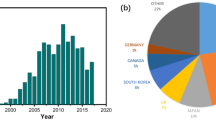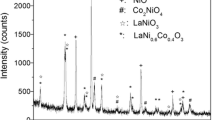Abstract
Solid oxide fuel cell (SOFC) is an attractive device that can convert chemical into energy. Recently, the triple layer hollow fiber (TLHF) opens up a new discovery of higher power output. This study investigates the fabrication of TLHF in solid oxide fuel cell consisting anode/anode functional layer (AFL)/electrolyte (NiO-YSZ/NiO-YSZ/YSZ) via single-step phase inversion-based co-extrusion combined with co-sintering technique using methane as fuel. TLHF formed sandwich-like structure that corresponds to the anode and AFL with dense electrolyte. Initially, the open circuit voltage (OCV) was 1.1 V, after 90 min, the OCV dropped to 0.2 V due to the carbon deposits that caused poisoning. Meanwhile, the power density also reduces from 0.8 to 0.33 Wcm−2. SEM image carbon shows the carbon deposited causing crack and reached electrolyte layer. TEM of the Ni catalyst indicates there are multilayer of graphite exhibit at the Ni particle courtesy of the carbon deposits. The results showed the graphite causing the performance to decrease which is corresponding to the usage of methane as fuel.










Similar content being viewed by others
References
Li C-X, Li C-J, Guo L-J (2010) Effect of composition of NiO/YSZ anode on the polarization characteristics of SOFC fabricated by atmospheric plasma spraying. Int J Hydrog Energy 35(7):2964–2969
Howe KS, Thompson GJ, Kendall K (2011) Micro-tubular solid oxide fuel cells and stacks. J Power Sources 196(4):1677–1686
Zhao Y, Xia C, Jia L, Wang Z, Li H, Yu J, Li Y (2013) Recent progress on solid oxide fuel cell: lowering temperature and utilizing non-hydrogen fuels. Int J Hydrog Energy 38(36):16498–16517
Kendall K, Minh NQ, Singhal SC (2003) Chapter 8—cell and stack designs, in high temperature and solid oxide fuel cells. Elsevier Science, Amsterdam, pp 197–228
Akhtar N, Kendall K (2011) Micro-tubular, solid oxide fuel cell stack operated under single-chamber conditions. Int J Hydrog Energy 36(20):13083–13088
Meng X, Yang N, Meng B, Tan X, Yin Y, Ma Z-F, Sunarso J (2012) Microstructure tailoring of the nickel–yttria stabilised zirconia (Ni–YSZ) cermet hollow fibres. Ceram Int 38(8):6327–6334
Hatchwell C, Sammes NM, Brown IWM, Kendall K (1999) Current collectors for a novel tubular design of solid oxide fuel cell. J Power Sources 77(1):64–68
Grande FD, Thursfield A, Kanawka K, Droushiotis N, Doraswami U, Li K, Kelsall G, Metcalfe IS (2009) Microstructure and performance of novel Ni anode for hollow fibre solid oxide fuel cells. Solid State Ionics 180(11–13):800–804
Bi L, Fabbri E, Traversa E (2012) Effect of anode functional layer on the performance of proton-conducting solid oxide fuel cells (SOFCs). Electrochem Commun 16(1):37–40
Zhang X, Qiu YE, Jin F, Guo F, Song Y, Zhu B (2013) A highly active anode functional layer for solid oxide fuel cells based on proton-conducting electrolyte BaZr0.1Ce0.7Y0.2O3−δ. J Power Sources 241:654–659
Yamaguchi T, Sumi H, Hamamoto K, Suzuki T, Fujishiro Y, Carter JD, Barnett SA (2014) Effect of nanostructured anode functional layer thickness on the solid-oxide fuel cell performance in the intermediate temperature. Int J Hydrog Energy 39(34):19731–19736
Meng X, Yang N, Gong X, Yin Y, Ma Z-F, Tan X, Shao Z, Liu S (2015) Novel cathode-supported hollow fibers for light weight micro-tubular solid oxide fuel cells with an active cathode functional layer. J Mater Chem A 3(3):1017–1022
Li T, Wu Z, Li K (2015) Co-extrusion of electrolyte/anode functional layer/anode triple-layer ceramic hollow fibres for micro-tubular solid oxide fuel cells–electrochemical performance study. J Power Sources 273:999–1005
Suzuki T, Sugihara S, Yamaguchi T, Sumi H, Hamamoto K, Fujishiro Y (2011) Effect of anode functional layer on energy efficiency of solid oxide fuel cells. Electrochem Commun 13(9):959–962
Chen K, Chen X, Lü Z, Ai N, Huang X, Su W (2008) Performance of an anode-supported SOFC with anode functional layers. Electrochim Acta 53(27):7825–7830
Mohd Hafiz Dzarfan O, Mukhlis AR, Kang L, Juhana J, Hasrinah H, Ahmad Fauzi I (2015) Ceramic hollow-fiber support through a phase inversion-based extrusion/sintering technique for high-temperature energy conversion systems, in Membrane Fabrication. CRC Press, Boca Raton, pp 347–382
Mohd Hafiz Dzarfan Othman, Siti Munira Jamil, Mukhlis A. Rahman, Juhana Jaafar and A.F. Ismail, Electrolyte hollow fiber as support via phase-inversion-based extrusion/sintering technique for micro tubular solid oxide fuel cell, in Frontiers in Ceramic Science. 2017. p. 107–131
Wang H, Liu J (2012) Effect of anode structure on performance of cone-shaped solid oxide fuel cells fabricated by phase inversion. Int J Hydrog Energy 37(5):4339–4345
Mahmud LS, Muchtar A, Somalu MR (2017) Challenges in fabricating planar solid oxide fuel cells: a review. Renew Sust Energ Rev 72:105–116
He B, Ling Y, Xu J, Zhao L, Cheng J (2014) Effect of nickel impregnated hollow fiber anode for micro tubular solid oxide fuel cells. J Power Sources 258:391–394
Meng X, Gong X, Yin Y, Yang N, Tan X, Ma Z-F (2014) Effect of the co-spun anode functional layer on the performance of the direct-methane microtubular solid oxide fuel cells. J Power Sources 247:587–593
Li T, Wu Z, Li K (2014) Single-step fabrication and characterisations of triple-layer ceramic hollow fibres for micro-tubular solid oxide fuel cells (SOFCs). J Membr Sci 449:1–8
Sun W, Zhang N, Mao Y, Sun K (2012) Fabrication of anode-supported Sc2O3-stabilized-ZrO2 electrolyte micro-tubular solid oxide fuel cell by phase-inversion and dip-coating. Electrochem Commun 20:117–120
Meng X, Yan W, Yang N, Tan X, Liu S (2015) Highly stable microtubular solid oxide fuel cells based on integrated electrolyte/anode hollow fibers. J Power Sources 275:362–369
Droushiotis N, Othman MHD, Doraswami U, Wu Z, Kelsall G, Li K (2009) Novel co-extruded electrolyte–anode hollow fibres for solid oxide fuel cells. Electrochem Commun 11(9):1799–1802
Park SY, Ahn JH, Jeong CW, Na CW, Song RH, Lee JH (2014) Ni-YSZ-supported tubular solid oxide fuel cells with GDC interlayer between YSZ electrolyte and LSCF cathode. Int J Hydrog Energy 39(24):12894–12903
Balachandran U, Dusek JT, Maiya PS, Ma B, Mieville RL, Kleefisch MS, Udovich CA (1997) Ceramic membrane reactor for converting methane to syngas. Catal Today 36(3):265–272
Asano K, Hibino T, Iwahara H (1995) A novel solid oxide fuel-cell system using the partial oxidation of methane. J Electrochem Soc 142(10):3241–3245
Assabumrungrat S, Laosiripojana N, Piroonlerkgul P (2006) Determination of the boundary of carbon formation for dry reforming of methane in a solid oxide fuel cell. J Power Sources 159(2):1274–1282
Lee D, Myung J, Tan J, Hyun S-H, Irvine JTS, Kim J, Moon J (2017) Direct methane solid oxide fuel cells based on catalytic partial oxidation enabling complete coking tolerance of Ni-based anodes. J Power Sources 345:30–40
Zhu H, Wang W, Ran R, Shao Z (2013) A new nickel–ceria composite for direct-methane solid oxide fuel cells. Int J Hydrog Energy 38(9):3741–3749
Wang Y-G, Sun L-L, Luo L-H, Wu Y-F, Liu L-L, Shi J-J (2014) The study of portable direct-flame solid oxide fuel cell (DF-SOFC) stack with butane fuel. J Fuel Chem Technol 42(9):1135–1139
Kim T, Liu G, Boaro M, Lee SI, Vohs JM, Gorte RJ, Al-Madhi OH, Dabbousi BO (2006) A study of carbon formation and prevention in hydrocarbon-fueled SOFC. J Power Sources 155(2):231–238
da Silva CA, de Miranda PEV (2015) Synthesis of LaAlO3 based materials for potential use as methane-fueled solid oxide fuel cell anodes. Int J Hydrog Energy 40(32):10002–10015
Harun Z, Hubadillah SK, Hasan S, Yunos MZ (2014) Effect of thermodynamic properties on porosity of ceramic membrane prepared by phase inversion. Appl Mech Mater 575:31–35
Hubadillah SK, Othman MHD, Ismail AF, Rahman MA, Jaafar J, Iwamoto Y, Honda S, Dzahir MIHM, Yusop MZM (2018) Fabrication of low cost, green silica based ceramic hollow fibre membrane prepared from waste rice husk for water filtration application. Ceram Int 44(9):10498–10509
Hubadillah SK, Othman MHD, Ismail AF, Rahman MA, Jaafar J (2018) A low cost hydrophobic kaolin hollow fiber membrane (h-KHFM) for arsenic removal from aqueous solution via direct contact membrane distillation. Sep Purif Technol
Hubadillah SK, Othman MHD, Matsuura T, Rahman MA, Jaafar J, Ismail AF, Amin SZM (2018) Green silica-based ceramic hollow fiber membrane for seawater desalination via direct contact membrane distillation. Sep Purif Technol 205:22–31
Kingsbury BFK, Li K (2009) A morphological study of ceramic hollow fibre membranes. J Membr Sci 328(1–2):134–140
Wang B, Lai Z (2012) Finger-like voids induced by viscous fingering during phase inversion of alumina/PES/NMP suspensions. J Membr Sci 405–406:275–283
Othman MHD, Droushiotis N, Wu Z, Kelsall G, Li K (2012) Dual-layer hollow fibres with different anode structures for micro-tubular solid oxide fuel cells. J Power Sources 205:272–280
Othman, M.H.D., Droushiotis, N., Wu, Z., Kelsall, G., and Li, K., High-performance, anode-supported, microtubular SOFC prepared from single-step-fabricated, dual-layer hollow fibers. Advanced Materials, 2011. 23(21): p. 2480–2483
Othman MHD, Wu Z, Droushiotis N, Kelsall G, Li K (2010) Morphological studies of macrostructure of Ni–CGO anode hollow fibres for intermediate temperature solid oxide fuel cells. J Membr Sci 360(1–2):410–417
Bayati R, Molaei R, Richmond A, Nori S, Wu F, Kumar D, Narayan J, Reynolds JG, Reynolds CL (2014) Modification of properties of yttria stabilized zirconia epitaxial thin films by excimer laser annealing. ACS Appl Mater Interfaces 6(24):22316–22325
Hanna J, Lee WY, Shi Y, Ghoniem AF (2014) Fundamentals of electro- and thermochemistry in the anode of solid-oxide fuel cells with hydrocarbon and syngas fuels. Prog Energy Combust Sci 40:74–111
Chen K, Lü Z, Ai N, Huang X, Zhang Y, Ge X, Xin X, Chen X, Su W (2007) Fabrication and performance of anode-supported YSZ films by slurry spin coating. Solid State Ionics 177(39–40):3455–3460
Baker RTK, Barber MA, Harris PS, Feates FS, Waite RJ (1972) Nucleation and growth of carbon deposits from the nickel catalyzed decomposition of acetylene. J Catal 26(1):51–62
Trimm DL (1997) Coke formation and minimisation during steam reforming reactions. Catal Today 37(3):233–238
Cimenti M, Hill MJ (2009) Direct utilization of liquid fuels in SOFC for portable applications: challenges for the selection of alternative anodes. Energies 2(2)
He H, Hill JM (2007) Carbon deposition on Ni/YSZ composites exposed to humidified methane. Appl Catal A Gen 317(2):284–292
Yang RT, Goethel PJ, Schwartz JM, Lund CRF (1990) Solubility and diffusivity of carbon in metals. J Catal 122(1):206–210
Sumi H, Lee Y-H, Muroyama H, Matsui T, Kamijo M, Mimuro S, Yamanaka M, Nakajima Y, Eguchi K (2011) Effect of carbon deposition by carbon monoxide disproportionation on electrochemical characteristics at low temperature operation for solid oxide fuel cells. J Power Sources 196(10):4451–4457
Sameshima S, Furukawa N, Hirata Y, Shimonosono T (2014) Cell performance of SOFC using CH4–CO2 mixed gases. Ceram Int 40(4):6279–6284
Acknowledgments
The authors gratefully acknowledge financial support from Universiti Teknologi Malaysia under Research University Grant R&D Fund (Project number: Q.J130000.7746.4J309) and Tier 1 (Project number: Q.J130000.2546.16H40)). The authors would also like to thank Research Management Centre, Universiti Teknologi Malaysia for the technical support.
Author information
Authors and Affiliations
Corresponding author
Additional information
Publisher’s note
Springer Nature remains neutral with regard to jurisdictional claims in published maps and institutional affiliations.
Rights and permissions
About this article
Cite this article
Mohamed, M.H., Othman, M.H.D., Mohd Yusop, M.Z. et al. Stability study of triple layer hollow fiber in solid oxide fuel cell with methane as fuel. Ionics 26, 3073–3083 (2020). https://doi.org/10.1007/s11581-020-03506-8
Received:
Revised:
Accepted:
Published:
Issue Date:
DOI: https://doi.org/10.1007/s11581-020-03506-8




